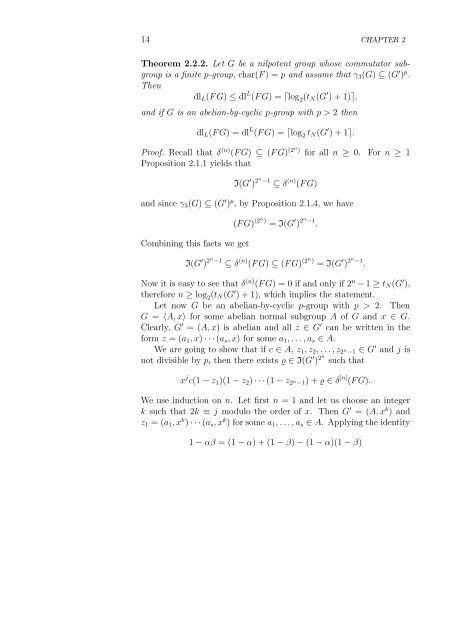On the Derived Length of Lie Solvable Group Algebras
On the Derived Length of Lie Solvable Group Algebras
On the Derived Length of Lie Solvable Group Algebras
Create successful ePaper yourself
Turn your PDF publications into a flip-book with our unique Google optimized e-Paper software.
14 CHAPTER 2<br />
Theorem 2.2.2. Let G be a nilpotent group whose commutator subgroup<br />
is a finite p-group, char(F ) = p and assume that γ3(G) ⊆ (G ′ ) p .<br />
Then<br />
dlL(F G) ≤ dl L (F G) = ⌈log 2(tN(G ′ ) + 1)⌉,<br />
and if G is an abelian-by-cyclic p-group with p > 2 <strong>the</strong>n<br />
dlL(F G) = dl L (F G) = ⌈log 2 tN(G ′ ) + 1⌉.<br />
Pro<strong>of</strong>. Recall that δ (n) (F G) ⊆ (F G) (2n ) for all n ≥ 0. For n ≥ 1<br />
Proposition 2.1.1 yields that<br />
I(G ′ ) 2n −1 ⊆ δ (n) (F G)<br />
and since γ3(G) ⊆ (G ′ ) p , by Proposition 2.1.4, we have<br />
Combining this facts we get<br />
(F G) (2n ) = I(G ′ ) 2 n −1 .<br />
I(G ′ ) 2n −1 ⊆ δ (n) (F G) ⊆ (F G) (2 n ) = I(G ′ ) 2 n −1 .<br />
Now it is easy to see that δ (n) (F G) = 0 if and only if 2n − 1 ≥ tN(G ′ ),<br />
<strong>the</strong>refore n ≥ log2(tN(G ′ ) + 1), which implies <strong>the</strong> statement.<br />
Let now G be an abelian-by-cyclic p-group with p > 2. Then<br />
G = 〈A, x〉 for some abelian normal subgroup A <strong>of</strong> G and x ∈ G.<br />
Clearly, G ′ = (A, x) is abelian and all z ∈ G ′ can be written in <strong>the</strong><br />
form z = (a1, x) · · · (as, x) for some a1, . . . , as ∈ A.<br />
We are going to show that if c ∈ A, z1, z2, . . . , z2n−1 ∈ G ′ and j is<br />
not divisible by p, <strong>the</strong>n <strong>the</strong>re exists ϱ ∈ I(G ′ ) 2n such that<br />
x j c(1 − z1)(1 − z2) · · · (1 − z2 n −1) + ϱ ∈ δ [n] (F G).<br />
We use induction on n. Let first n = 1 and let us choose an integer<br />
k such that 2k ≡ j modulo <strong>the</strong> order <strong>of</strong> x. Then G ′ = (A, x k ) and<br />
z1 = (a1, x k ) · · · (as, x k ) for some a1, . . . , as ∈ A. Applying <strong>the</strong> identity<br />
1 − αβ = (1 − α) + (1 − β) − (1 − α)(1 − β)


